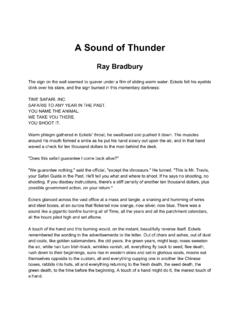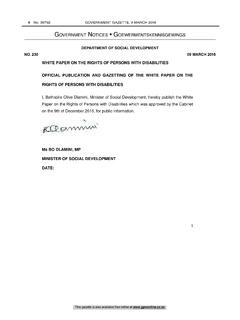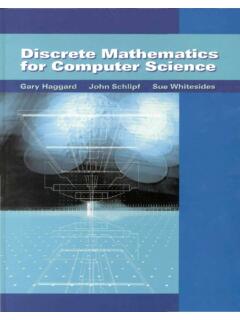Transcription of Introduction to Group Theory for Physicists
1 Introduction to Group Theoryfor PhysicistsMarina von SteinkirchState University of New York at Stony 12, 20112 PrefaceThese notes started after a great course in Group Theory by Dr. Van Nieuwen-huizen [8] and were constructed mainly following Georgi s book [3], and otherclassical references. The purpose was merely educative. This book is madeby a graduate student to other graduate students. I had a lot of fun put-ing together my readings and calculations and I hope it can be useful forsomeone von Steinkirch,August of Finite Subgroups and Definitions .. Representations .. Reality of Irreducible Representations .. Transformation Groups .. 162 Lie Lie Algebras .. Representations .. The Defining Representation .. The Adjoint Representation .. The Roots .. The Cartan Matrix and Dynkin Diagrams .. Casimir Operators .. *Weyl Group .. *Compact and Non-Compact Generators.
2 *Exceptional Lie Groups .. 363 SU(N), The Defining Representation .. The Cartan GeneratorsH.. The Weights .. The Roots .. The Fundamental Weights~q.. The Killing Metric .. The Cartan Matrix .. (2).. (3).. 4356 CONTENTS4 SO(2N), The Defining Representation .. The Cartan GeneratorsH.. The Weights .. The Raising and Lowering OperatorsE .. The Roots .. The Fundamental Weights~q.. The Cartan Matrix .. 535 SO(2N+1), The Cartan GeneratorsH.. The Weights .. The Raising and Lowering OperatorsE .. The Roots .. The Fundamental Weights~q.. The Cartan Matrix .. 586 Spinor The Dirac Group .. Spinor Irreps on SO(2N+1) .. Spinor Irreps on SO(2N+2) .. Reality of the Spinor Irrep .. Embedding SU(N) into SO(2N) .. 667 Sp(2N), The Cartan GeneratorsH.
3 The Weights .. The Raising and Lowering OperatorsE .. The Roots .. The Fundamental Weightsq.. The Cartan Matrix .. 718 Young Invariant Tensors .. Dimensions of Irreps of SU(N) .. Dimensions of Irreps of SO(2N) .. Dimensions of Irreps of SO(2N+1) .. Dimensions of Irreps of Sp(2N) .. Branching Rules .. 83 CONTENTS79 The Gauge GroupSU(5)as a simple The Representation of the Standard Model .. (5) Unification ofSU(3) SU(2) U(1) .. Anomalies .. Physical Consequences of usingSU(5) as a GUT Theory .. 9210 Geometrical Proprieties of Groups and Other Nice Features Covering Groups .. Invariant Integration .. 98A Table of Groups1038 CONTENTSC hapter 1 Finite GroupsAfinite groupis a Group with finite number of elements, which is called theorder of the Group . AgroupGis a set of elements,g G, which under someoperation rules follows the common proprieties1.
4 Closure:g1andg2 G, theng1g2 Associativity:g1(g2g3) = (g1g2) Inverse element: for everyg Gthere is an inverseg 1 G, andg 1g=gg 1= Identity Element: every groups containse G, andeg=ge= Subgroups and DefinitionsAsubgroupHof a groupGis a set of elements ofGthat for any giveng1,g2 Hand the multiplicationg1g2 H,G, one has again the previousfour Group proprieties. For example,S3hasZ3as a subgroup1. The trivialsubgroups are the identityeand the cosetof the subgroupHinGis a set of elements formed by theaction ofHon the left of a element ofg G, Theleft each coset has [H] elements2and for two cosets of the same Group one hasgH1=gH2, thenH1=H2, meaning that cosets do not groups will be defined on the text, and they are quickly summarized on , in the end of this [G] is the notation for number of elements (order) of the 1. FINITE GROUPSL agrange s TheoremThe order of the cosetH, [H] is a divisor of [G],[G] = [H] ncosets,wherencosetsis the number of cosets example, the permutation groupS3has orderN!
5 = 3! = 6, conse-quently it can only have subgroups of order 1, 2, 3 and 6. Another directconsequence is that groups of prime order have noproper(non-trivial) sub-groups, prime groups only have the trivialH=eandH= or Normal or Self-conjugated Subgroup3If for every element of the Group ,g G, one has the equalitygH=Hg, the right coset is equal to the left coset, the subgroup isinvariant. ThetrivialeandGare invariant subgroups of every a invariant coset of a Group , we can see the coset-space as a Group ,regarding each coset as a element of the space. The coset spaceG/H, whichis the sets of cosets, is a factor Group given by the factor ClassesClasses are the set of elements (not necessary a subgroup) of a Group G thatobeyg 1Sg=S, for allg G. The termgSg 1is the conjugate ofS. Fora finite Group , the number of classes of a Group is equal to the number ofirreducible representations (irreps). For example, the conjugate classes ofS3are [e,(a1,a2),(a3,a4,a5)].
6 An invariant subgroup is composed of the union of all (entire) classes ofG. Conversely, a subgroup of entire classes is an invariant of the RelationsTheequivalence relationsbetween two sets (which can be classes) are givenby1. Reflexivity:a Symmetry: ifa b, thenb Transitivity: ifa candb c, thena shall use the term invariant in this SUBGROUPS AND DEFINITIONS11 Quotient GroupAquotient groupis a Group obtained by identifying elements of a larger groupusing an equivalence relation. The resulting quotient is writtenG/N4, whereGis the original Group andNis the invariant set of cosetsG/Hcan be endowed with a Group structure by asuitable definition of two cosets, (g1H)(g2H) =g1g2H, whereg1g2is a newcoset. A groupGis a direct product of its subgroupsAandBwritten asG=A Bif1. All elements of A commute to Every element of G can be written in a unique way asg=abwitha A,b BothAandBare invariant subgroups of a GroupZ(G)Thecenterof a groupGis the set of elements ofGthat commutes with allelements of this Group .
7 The center can be trivial consisting only center forms anabelian5invariant subgroupand the whole groupGisabelian only ifZ(G) = example, for the Lie Group SU(N), the center is isomorphic to thecyclic groupZn, the largest Group of commuting elements of SU(N) is'Zn. For instance, for SU(3), the center is the three matrices 3 3, withdiag(1,1,1), diag(e2 i3,e2 i3,e2 i3) and diag(e4 i3,e4 i3,e4 i3), which clearly is aphase and has determinant equals to one. On the another hand, the centerof U(N) is an abelian invariant subgroup and for this reason the unitarygroup is finite groups, the center is isomorphic to the trivial groupforSn,N 3 andAn,N of an Element of a GroupcG(a)The centralizer ofa,cG(a) is a new subgroup inGformed byga=ag, set of elements ofGwhich commutes is abelian Group is one which the multiplication law is commutativeg1g2= will see that semi-simple Lie groups are direct sum of simple Lie algebras, Lie 1.
8 FINITE GROUPSAn elementaofGlies in the centerZ(G) ofGif and only if its conjugacyclass has only one element,aitself. The centralizer is the largest subgroupofGhavingaas it center and the order of the centralizer is related toGby[G] = [cG(a)] [class(a)].Commutator SubgroupC(G)Thecommutator groupis the Group generated from all commutators of thegroup. For elementsg1andg2of a groupG, the commutator is defined as[g1,g2] =g 11g commutator is equal to the identity elementeifg1g2=g2g1, thatis, ifg1andg2commute. However, in general,g1g2=g2g1[g1,g2].Fromg1g2g 11g 12one forms finite products and generates an invari-ant subgroup, where the invariance can be proved by inserting a unit ong(g1g2g 11g 12)g 1=g g commutator Group is the smallest invariant subgroup ofGsuch thatG/C(G) is abelian, which means that the large the commutator subgroupis, the less abelian the Group is. For example, the commutator RepresentationsArepresentationis a mappingD(g) ofGonto a set, respecting the (e) = 1 is the identity (g1)D(g2) =D(g1g2).
9 The dimension of a representation is the dimension of the space on whereit acts. A representation isfaithfulwhen forD(g1)6=D(g2),g16=g2, for allg1, Schur s LemmasConcerning to representation Theory of groups, theSchur s Lemmaare1. IfD1(g)A=AD2(g) orA 1D1(g)A=D2(g), g G, whereD1(g)andD2are inequivalent irreps, thenA= REPRESENTATIONS132. IfD(g)A=AD(g) orA 1D(g)A=D(g), g G, whereD(g) is afinite dimensional irrep, thenA I. In other words, any matrix Acommutes with all matricesD(g) if it is proportional to the unitarymatrix. One consequence is that the form of the basis of an irrep isunique, g RepresentationA representation is unitary if all matricesD(g) are unitary. Every represen-tation of a compact finite Group is equivalent to a unitary representation,D =D (g) be a representation of a finite groupG. ConstructingS= g GD(g) D(g),it can be diagonalized with non-negative eigenvaluesS=U 1dU, withddi-agonal. One then makesx=S1/2=U 1 dU, from this, one defines the uni-taryD (g) =xD(g)x 1.
10 Finally, one hasD (g) D (g) =x 1D(g) SD(g)x 1= and Irreducible RepresentationA representation is reducible if it has an invariant subspace, which meansthat an action of aD(g) on any vector in the subspace is still a subspace,for example by using a projector on the regular representation (such asPD(g) =P, g). An irrep is a representation that has no nontrivial representation of a finite Group is completely reducible and it isequivalent to the block diagonal form. For this reason, any representationof a finite or semi-simple Group can breaks up into a direct sum of can always construct a new representation by a transformationD(g) D (g) =A 1D(g)A,( )whereD(g) andD (g) are equivalent representations, only differing by choiceof basis. This new representation can be made diagonal, with blocks repre-senting its irreps. The criterium of diagonalization of a matrixD(g) is thatit commutes toD(g) .14 CHAPTER 1. FINITE GROUPSC haractersThecharacterof a representation of a groupGis given by the trace ofthis representation.









